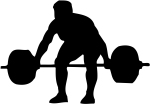- FreeTrainers.com Forums
- Strength & Powerlifting
- Strength training for endurance runners.
Group: Strength & Powerlifting
Created: 2012/01/01,
Members: 39,
Messages: 16459
Discuss the topic of Power lifting, Strength training and Strong Man training!
Join group
Strength training for endurance runners.

wrestler125
Posts:
4,619
Joined: 2004/01/27  |
2007/02/20, 11:00 AM
A review:
Sports Med. 2003;33(7):539-52. Related Articles, Links The impact of resistance training on distance running performance. Jung AP. Department of Kinesiology, University of Alabama, Tuscaloosa, Alabama 35487-0312, USA. ajung@bamaed.ua.edu Traditionally, distance running performance was thought to be determined by several characteristics, including maximum oxygen consumption (VO(2max)), lactate threshold (LT), and running economy. Improvements in these areas are primarily achieved through endurance training. Recently, however, it has been shown that anaerobic factors may also play an important role in distance running performance. As a result, some researchers have theorised that resistance training may benefit distance runners. Because resistance training is unlikely to elicit an aerobic stimulus of greater than 50% of VO(2max), it is unlikely that resistance training would improve VO(2max) in trained distance runners. However, it appears that VO(2max) is not compromised when resistance training is added to an endurance programme. Similarly, LT is likely not improved as a result of resistance training in trained endurance runners; however, improvements in LT have been observed in untrained individuals as a result of resistance training. Trained distance runners have shown improvements of up to 8% in running economy following a period of resistance training. Even a small improvement in running economy could have a large impact on distance running performance, particularly in longer events, such as marathons or ultra-marathons. The improvement in running economy has been theorised to be a result of improvements in neuromuscular characteristics, including motor unit recruitment and reduced ground contact time. Although largely theoretical at this point, if resistance training is to improve distance running performance, it will likely have the largest impact on anaerobic capacity and/or neuromuscular characteristics. The primary purpose of this review is to consider the impact of resistance training on the factors that are known to impact distance running performance. A second purpose is to consider different modes of resistance exercise to determine if an optimal protocol exists. -------------- Gravity hates you. Enter the Darkside. |
|
| |

wrestler125
Posts:
4,619
Joined: 2004/01/27  |
2007/02/20, 11:01 AM
And a study...
Explosive-strength training improves 5-km running time by improving running economy and muscle power. Paavolainen L, Hakkinen K, Hamalainen I, Nummela A, Rusko H. KIHU-Research Institute for Olympic Sports, University of Jyvaskyla, SF-40700 Jyvaskyla, Finland. LPAAVOLA@KIHU.JYU.FI To investigate the effects of simultaneous explosive-strength and endurance training on physical performance characteristics, 10 experimental (E) and 8 control (C) endurance athletes trained for 9 wk. The total training volume was kept the same in both groups, but 32% of training in E and 3% in C was replaced by explosive-type strength training. A 5-km time trial (5K), running economy (RE), maximal 20-m speed (V20 m), and 5-jump (5J) tests were measured on a track. Maximal anaerobic (MART) and aerobic treadmill running tests were used to determine maximal velocity in the MART (VMART) and maximal oxygen uptake (VO2 max). The 5K time, RE, and VMART improved (P < 0.05) in E, but no changes were observed in C. V20 m and 5J increased in E (P < 0.01) and decreased in C (P < 0.05). VO2 max increased in C (P < 0.05), but no changes were observed in E. In the pooled data, the changes in the 5K velocity during 9 wk of training correlated (P < 0.05) with the changes in RE and VMART (r = 0.55). In conclusion, the present simultaneous explosive-strength and endurance training improved the 5K time in well-trained endurance athletes without changes in their VO2 max. This improvement was due to improved neuromuscular characteristics that were transferred into improved VMART and running economy. Full text : http://jap.physiology.org/cgi/content/full/86/5/1527 -------------- Gravity hates you. Enter the Darkside. |

wrestler125
Posts:
4,619
Joined: 2004/01/27  |
2007/02/20, 11:04 AM
The review is pretty easy to read, so I'll just jump right into Paavolainen's study...
In other words, two groups of runners... One group REPLACED some of their track time with time in the weight room, while one continued regular training. The group that was spending time in the weight room showed more improvement than the control group, even though they were doing less running. -------------- Gravity hates you. Enter the Darkside. |

arondaballer
Posts:
1,054
Joined: 2003/06/14  |
2007/02/22, 11:10 AM
Good stuff. It really makes sense because on a bigger scale, running time is literally a measurement of power. You increase your power by...
1. Increasing the distance in the same amount of time 2. Decrease the time in which you run a distance or both This should always be your goal in the weight room as an athlete...even endurance...So this makes perfect sense. I have also read a study concerning swimming endurance and power output. I'll try to find it. Someone tell me if I sound like I'm talkin out my butt...it's been a while lol. -------------- I firmly believe that any man's finest hour, the greatest fulfillment of all that he holds dear, is the moment when he has worked his heart out in a good cause and lies exhausted on the field of battle-victorious. --Vince Lombardi "Decide what you want, decide what you are willing to exchange for it. Establish your priorities and go to work." H. L. Hunt |
